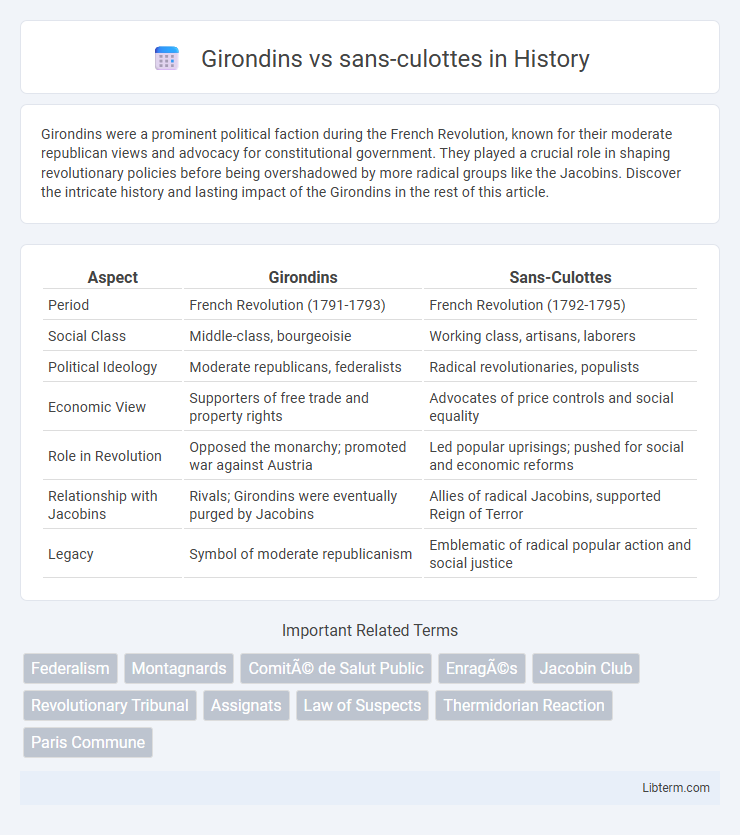Girondins were a prominent political faction during the French Revolution, known for their moderate republican views and advocacy for constitutional government. They played a crucial role in shaping revolutionary policies before being overshadowed by more radical groups like the Jacobins. Discover the intricate history and lasting impact of the Girondins in the rest of this article.
Table of Comparison
| Aspect | Girondins | Sans-Culottes |
|---|---|---|
| Period | French Revolution (1791-1793) | French Revolution (1792-1795) |
| Social Class | Middle-class, bourgeoisie | Working class, artisans, laborers |
| Political Ideology | Moderate republicans, federalists | Radical revolutionaries, populists |
| Economic View | Supporters of free trade and property rights | Advocates of price controls and social equality |
| Role in Revolution | Opposed the monarchy; promoted war against Austria | Led popular uprisings; pushed for social and economic reforms |
| Relationship with Jacobins | Rivals; Girondins were eventually purged by Jacobins | Allies of radical Jacobins, supported Reign of Terror |
| Legacy | Symbol of moderate republicanism | Emblematic of radical popular action and social justice |
Introduction to Girondins and Sans-Culottes
The Girondins were a moderate political faction in the French Revolution, advocating for a constitutional government and opposing the radical changes demanded by the lower classes. The Sans-Culottes, representing the working-class urban poor, pushed for more radical social and economic reforms, emphasizing direct democracy and social equality. Conflicts between the Girondins and Sans-Culottes highlighted the growing divide between revolutionary moderates and extremists during the period.
Historical Background of the French Revolution
The Girondins and the Sans-culottes represented two influential political factions during the French Revolution, reflecting deep social and ideological divides. The Girondins, originating from the bourgeoisie, advocated for a constitutional government and opposed radical measures, while the Sans-culottes, composed mainly of working-class revolutionaries from Paris, pushed for direct democracy and economic equality. The conflict between moderate Girondins and radical Sans-culottes intensified following the fall of the monarchy, significantly shaping the revolutionary government's policies and the course of the Reign of Terror.
Political Ideologies: Girondins vs Sans-Culottes
The Girondins embraced moderate republicanism advocating for a constitutional government and cautious political reforms, while the Sans-Culottes supported radical egalitarianism and direct popular rule. Girondins favored federalism and feared concentrated power, opposing the centralized control championed by the Sans-Culottes. The ideological clash centered on the Girondins' defense of bourgeois interests against the Sans-Culottes' push for social justice and economic equality.
Social Composition of Both Factions
The Girondins primarily consisted of wealthy bourgeoisie, professionals, and provincial elites advocating for moderate republicanism and economic liberalism. In contrast, the Sans-culottes represented the urban working class and poor artisans of Paris, emphasizing radical social equality and direct democracy. This stark difference in social composition shaped their conflicting political goals during the French Revolution.
Key Leaders and Influential Figures
The Girondins were led by prominent figures such as Jacques Pierre Brissot and Jean-Marie Roland, who championed moderate republicanism and advocated for war with Austria. The Sans-culottes found leadership among radical revolutionaries like Georges Danton and Jean-Paul Marat, who represented the working-class insurgents and pushed for direct democracy and social equality. These key leaders shaped the ideological divide during the French Revolution, influencing both political strategies and revolutionary policies.
Major Events and Conflicts
The conflict between the Girondins and the sans-culottes intensified during the French Revolution, marked by the Girondins' moderate stance clashing with the sans-culottes' radical demands for social and economic equality. Key events include the insurrection of June 1793, when sans-culottes pressured the National Convention to arrest leading Girondin deputies, resulting in their purge and execution during the Reign of Terror. This struggle highlighted the power shift from bourgeois moderates to radical popular forces, significantly influencing revolutionary policies and escalating political violence.
Role in the National Convention
The Girondins played a prominent role in the early National Convention, advocating for a constitutional government and opposing the radical measures favored by the sans-culottes. The sans-culottes, representing the working-class radicals, pushed for direct democracy, social equality, and the execution of King Louis XVI, influencing the Convention to adopt more extreme revolutionary policies. Their conflict shaped key decisions, leading to the rise of the Jacobins and the Reign of Terror.
Impact on Revolutionary Policies
The Girondins advocated for a more moderate approach to the French Revolution, emphasizing constitutional monarchy and economic liberalism, while the Sans-culottes pushed for radical social and economic reforms driven by the working-class demands. The conflict between these factions shaped revolutionary policies by shifting power toward more radical legislation, including price controls, social welfare measures, and the Reign of Terror. This power dynamic resulted in significant changes to the direction of the revolution, impacting governance, social equality, and the enforcement of revolutionary ideals.
Decline and Legacy of the Girondins and Sans-Culottes
The Girondins faced a rapid decline during the French Revolution as they lost political influence due to their moderate stance, which alienated more radical factions and led to their purge by the Jacobins in 1793. The sans-culottes, representing the working-class radicals, played a crucial role in pushing revolutionary policies forward but gradually lost power following the Thermidorian Reaction and the rise of the Directory. The legacy of the Girondins remains tied to early revolutionary ideals of federalism and liberalism, while the sans-culottes are remembered for their pivotal role in shaping popular demands for social equality and direct democracy during the Revolution.
Lasting Influence on Modern Political Movements
The Girondins and sans-culottes significantly shaped modern political movements by laying early foundations for republicanism and grassroots activism. The Girondins advocated for representative government and civil liberties, influencing liberal democratic ideals across Europe. Meanwhile, the sans-culottes epitomized radical popular sovereignty and social justice, inspiring later socialist and populist movements.
Girondins Infographic

 libterm.com
libterm.com